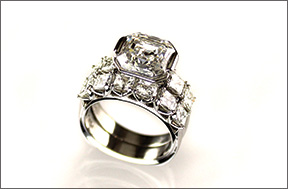Asscher Cut Diamond Design
When a customer brings you a 4.27 carat, E color, VS1 clarity, Asscher cut diamond, it's tough not to be intimidated and awed. The client, one of my best customers, also had very specific requirements for the platinum bridal set that would house the stone: The engagement ring and wedding band had to be comfortable, fit flush together, and show off the quality and shape of the stone. For the engagement ring, he wanted a simple yet unique mounting that would showcase the stone as best as possible. So I set off to do just that.
2 Minute Read
When a customer brings you a 4.27 carat, E color, VS1 clarity, Asscher cut diamond, it's tough not to be intimidated and awed. The client, one of my best customers, also had very specific requirements for the platinum bridal set that would house the stone.
The engagement ring and wedding band had to be comfortable, fit flush together, and show off the quality and shape of the stone. For the engagement ring, he wanted a simple yet unique mounting that would showcase the stone as best as possible. So I set off to do just that.
The award-winning Journal is published monthly by MJSA, the trade association for professional jewelry makers, designers, and related suppliers. It offers design ideas, fabrication and production techniques, bench tips, business and marketing insights, and trend and technology updates—the information crucial for business success. “More than other publications, MJSA Journal is oriented toward people like me: those trying to earn a living by designing and making jewelry,” says Jim Binnion of James Binnion Metal Arts.
Click here to read our latest articles
Click here to get a FREE four-month trial subscription.
You assume all responsibility and risk for the use of the safety resources available on or through this web page. The International Gem Society LLC does not assume any liability for the materials, information and opinions provided on, or available through, this web page. No advice or information provided by this website shall create any warranty. Reliance on such advice, information or the content of this web page is solely at your own risk, including without limitation any safety guidelines, resources or precautions, or any other information related to safety that may be available on or through this web page. The International Gem Society LLC disclaims any liability for injury, death or damages resulting from the use thereof.
The All-In-One Jewelry Making Solution At Your Fingertips
When you join the Ganoksin community, you get the tools you need to take your work to the next level.
Trusted Jewelry Making Information & Techniques
Sign up to receive the latest articles, techniques, and inspirations with our free newsletter.

